Visiting the monasteries of Pejë/ Peć in Kosovo
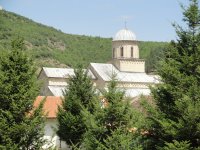 My family and I were on holiday in beautiful Montenegro, when we decided to take a daytrip into Kosovo – to the town of Pejë (in Albanian) / Peć (in Serbian).
My family and I were on holiday in beautiful Montenegro, when we decided to take a daytrip into Kosovo – to the town of Pejë (in Albanian) / Peć (in Serbian).
Of special interest to us were two spectacular Serbian Orthodox monasteries: the 14th century Dečani Monastery and the 13th century Patriarchate Monastery.
Travelling in the Balkans is wonderful: stunning nature, a mixture of cultures and influences and warm people. But it also requires lots of patience and flexibility, a spirit of adventure and the understanding that things don’t work the same as in other European destinations. As long as you are willing to accept this, you will certainly find this a rewarding destination.
This self-imposed patience and flexibility was sorely tested on our first attempt to cross into Kosovo from southeastern Montenegro. Although we missed the turnoff to Kosovo at the Montenegrin border town of Rožaje, road signs and our map confirmed a second border crossing into Kosovo.
We were surprised by all the shepherds using what was essentially a road to an international border crossing as a grazing area; we were increasingly suspicious when the asphalt ended and the twisting dirt road became narrower and narrower.
We stopped to ask, in our bad Montenegrin, two women herding cows if this was the road to Kosovo.
After having (rightfully) laughed at us, they pointed out that this road had been in disuse for years and that we would have created a lot of problems with the soldiers at the border. Lesson learned : don’t always trust maps or even road signs in the Balkans – always check with the locals.
We managed on attempt number two and crossed into Kosovo from the Rožaje border crossing. European nationals only require an identity card to enter Montenegro, but a passport is necessary in Kosovo.
Border crossing is smooth, but Kosovo is not recognized in international auto insurance policies, so you must also pay a mandatory 50 euro fee for Kosovar insurance (yes, even for a day).
 The drive through the Prokletije mountains and down to the valley of Pejë below is stunning and we were reminded of Switzerland or Austria.
The drive through the Prokletije mountains and down to the valley of Pejë below is stunning and we were reminded of Switzerland or Austria.
In the summertime, children sell berries they have picked in the forests along the road and they can often jump in front of cars, so drive cautiously. The road conditions are good.
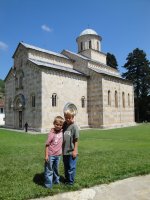 Pejë itself is a bustling, chaotic city with a tremendous amount of rebuilding underway. Road signs are erratic. However, there are many KFOR soldiers posted along the road and we asked for directions quite a few times to ensure that we were on the correct road to the Dečani Monastery.
Pejë itself is a bustling, chaotic city with a tremendous amount of rebuilding underway. Road signs are erratic. However, there are many KFOR soldiers posted along the road and we asked for directions quite a few times to ensure that we were on the correct road to the Dečani Monastery.
The Serbian Orthodox Dečani Monastery is just a few kilometers out of the city and is in a picturesque spot at the base of the Prokletije mountains.
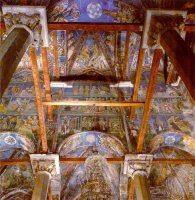 The stunning monastery, said to be the best-preserved medieval church in the Balkans, was named a UNESCO Heritage site in 2004, declaring it a place which “[combines] the influences of the eastern Orthodox Byzantine and the Western Romanesque traditions. The style played a decisive role in subsequent Balkan art.”
The stunning monastery, said to be the best-preserved medieval church in the Balkans, was named a UNESCO Heritage site in 2004, declaring it a place which “[combines] the influences of the eastern Orthodox Byzantine and the Western Romanesque traditions. The style played a decisive role in subsequent Balkan art.”
Dečani and the Orthodox priests living within it continue to be under the protection of Italian soldiers. You must have your passports ready. You will go through a check point and a barricaded area before being told to park. Your documents and bags will be inspected and you are accompanied to the door by the soldiers.
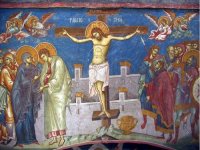 When we passed through the heavy gates, we felt as if we had been transported to another world. We were struck by the absolute beauty and tranquility of this monastery constructed at the beginning of the 14th century by King Stefan of Dečani.
When we passed through the heavy gates, we felt as if we had been transported to another world. We were struck by the absolute beauty and tranquility of this monastery constructed at the beginning of the 14th century by King Stefan of Dečani.
It is all stunning: the beautiful marble facade, the fantastically preserved frescoes, the picturesque monastery housing and flowers – all surrounded by walls with views outside to the Prokletije mountain range. We spent a long time examining the details of the frescoes extending throughout the entire surface area of the walls.
After considerable time at Dečani, we drove on to the Patriarchate Monastery, closer to Pejë and at the entrance of the stunning Rugova gorge.
The 13th century Patriarchate is home to Serbian Orthodox nuns and is also under the protection of Italian soldiers. The soldiers were very professional and efficient – photographing our car and its license plate and following procedures similar to those in Dečani before allowing us entrance.
 The frescoes here are also spectacular and span from the 13th through the 16th centuries, although they are less well-preserved than those at Dečani.
The frescoes here are also spectacular and span from the 13th through the 16th centuries, although they are less well-preserved than those at Dečani.
As in much of the Balkans, with its history of centuries of invasions and fighting, one is always in awe that these beautiful places still exist at all. We felt incredibly lucky to have visited these impressive landmarks and highly recommend a visit to these amazing monasteries.
We had very little time left for exploration of Pejë, but the Kosovar people were warm and welcoming to tourists. There is clearly not much tourism yet, so they are happy to encourage you to travel to other parts of Kosovo. We had an excellent lunch before bracing for the mountain drive back to Montenegro.
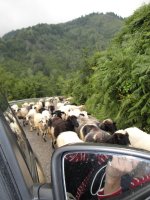
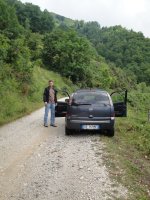
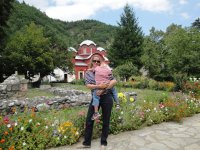
I’m enjoying these forays into lesser known areas. These enclaves sound so beautiful and it is wonderful to know they survived the war unscathed. How much those locals must have been through!
Definitely true about how much these places have been through. You can still see the bullet holes on the wall surrounding tne monastery, but when you walk through the gate, it’s so peaceful and idyllic.
Interesting reading, never been in that area… 🙂
An interesting corner of the Balkans – as yet, minus the hordes of tourists!
Thank you for sharing these beautiful photos with us. I feel like I’m having a mini getaway with your travel posts as they are such a welcome change to the dreary end of winter scenery around here.
Glad I could take you on a mini get-away, Janet. Sending some Roman sunshine your way… and hoping spring will arrive soon!
[…] week I wrote about the spectacular Orthodox monasteries of Kosovo, but Bulgaria’s Boyana church is another impressive example of Balkan Byzantine art that is […]